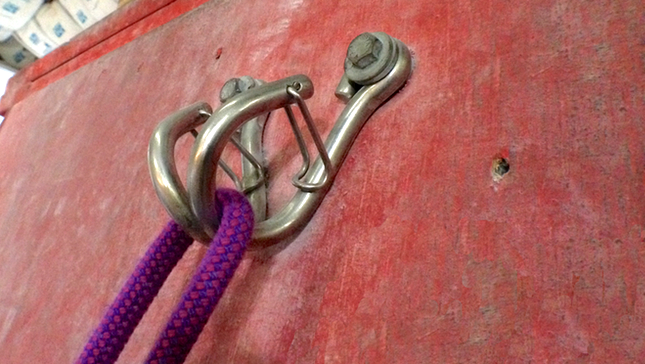
On April 28, 2008 Whitman College first-year student Stephanie Foster fell 35 feet from the top of the Sherwood climbing wall located in the college’s recreation center. Just two days after the wall had been closed for major construction, Foster landed on her back in the rubber chips at the base of the wall, fracturing her L1 vertebrae.
Athletic Business and Recreation-Law.com continue the story:
Foster was employed as a student climbing instructor for the college’s outdoor program. The day of the accident Foster was asked by her supervisor to remove several climbing ropes that were hanging from the top of the wall. Foster climbed atop a platform adjacent to the wall where she removed all but one of the ropes. All ropes were clipped into Fixe Super Shut anchors. Having completed her task, Foster lowered herself back onto the climbing wall and began rappelling down the wall using the remaining rope. During her descent, however, the rope became unhooked from its anchors, and Foster fell approximately 35 feet to the ground, suffering permanent injury to her spine.
A year before Foster’s fall, Whitman College had hired Adventure Safety International to perform a risk management audit of the outdoor program. Auditor Alex Kosseff met with several students and administrators who were involved with the outdoor program and also observed several activities utilizing the climbing wall. After completing his site visit, Kosseff submitted a written report of his findings and recommendations to Whitman College. The report assigned the outdoor program the highest rating, noting that the quality of the program’s equipment was “exceptional” and that those responsible for the program routinely inspected the facility for potential safety hazards.
As a result of her injuries, Foster filed a lawsuit against Kosseff and ASI, claiming that they were negligent for failing to identify the risks posed by the Super Shut anchors during ASI’s risk assessment audit.
After the accident the college hired the same auditor to investigate the accident. (Can you say conflict of interest?) The auditor submitted a report on his investigation into the accident. The report stated that the plaintiff had climbed above the Super Shut anchors which released the rope causing her to fall.
It was determined that Foster’s fall occurred because the Super Shut anchors were not designed to accommodate a person climbing above them. Had Kosseff identified that risk and reported it to Whitman College in the intial audit, Foster claimed, the problem could have been corrected before she was injured.
Kosseff and ASI moved for summary judgment, arguing that Foster’s negligence claims must fail as a matter of law because neither Kosseff nor ASI owed her a duty of care to identify the dangerous conditions that caused her to fall.
The court concluded that Foster was unable to establish that ASI owed her a duty of care to discover and report the danger posed by misuse of the Super Shut anchors. In the absence of a duty of a care, the court concluded, Foster could not win her negligence claim.
Under Washington’s law, someone who inspects the premises of another does not become the insurer of anyone injured by the negligence of the inspection. In most states, an inspecting party is only “liable for undiscovered hazards which he or she undertook to discover in the first place.” Meaning, you are only liable for what you say you are going to discover and don’t.
The court found that ASI did not contract with Whitman College to address dangers caused by misuse of the outdoor program’s equipment. The court also ruled that even if ASI had a duty to inspect individual pieces of equipment, it could not reasonably have been expected to identify hazards stemming from potential misuse of the equipment.
RISK INVESTMENT
Although Kosseff and ASI were not found negligent for Foster’s injuries, there are a couple of important points that sports and recreation administrators, as well as risk management auditors, should take away from the court’s decision.First, as the court noted, although the duty is limited to only inspecting the risks that they were hired to discover, risk management auditors do have a legal duty of care to those using the facility or program.
Second, since the main purpose of a risk management audit is to improve an organization’s safety practices rather than to identify and document specific safety hazards, risk management auditors are not insurers against all risks, and their legal duty of care will depend on the risks that were actually targeted by his or her inspection.
In the long term, colleges are going to be hesitant to build climbing walls because this case [against Whitman College] is going to settle or go to trial for a large amount of money. Spinal cord injuries are multimillion dollar cases.

Climbing Business Journal is an independent news outlet dedicated to covering the indoor climbing industry. Here you will find the latest coverage of climbing industry news, gym developments, industry best practices, risk management, climbing competitions, youth coaching and routesetting. Have an article idea? CBJ loves to hear from readers like you!






